Organisational Behaviour: Culture, Power, Motivation & Effective Teams
VerifiedAdded on 2023/06/18
|14
|4025
|129
Report
AI Summary
This report examines organisational behaviour within the context of Mark and Spencer, focusing on the influence of culture, power, and politics on individual and team behaviour. It analyses how content and process theories of motivation, such as Maslow's hierarchy of needs, Herzberg's two-factor theory, and goal-setting theory, enable the achievement of organisational goals. The report also differentiates between effective and ineffective teams, highlighting key factors that contribute to team success. Finally, it explores various concepts and philosophies of organisational behaviour, providing insights into their practical application in a business setting. The analysis emphasizes the importance of understanding these elements for fostering a positive and productive work environment.
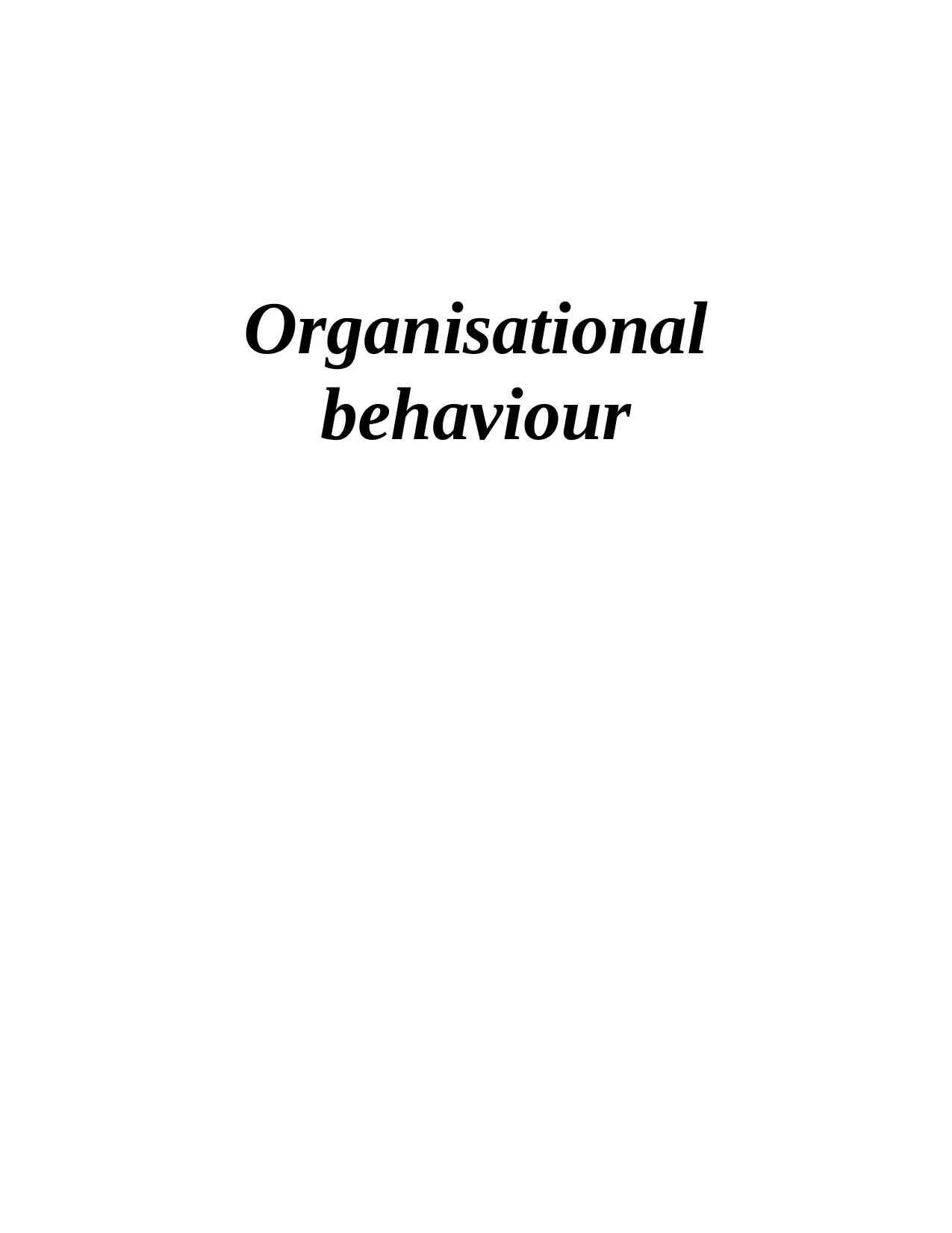
Organisational
behaviour
behaviour
Paraphrase This Document
Need a fresh take? Get an instant paraphrase of this document with our AI Paraphraser
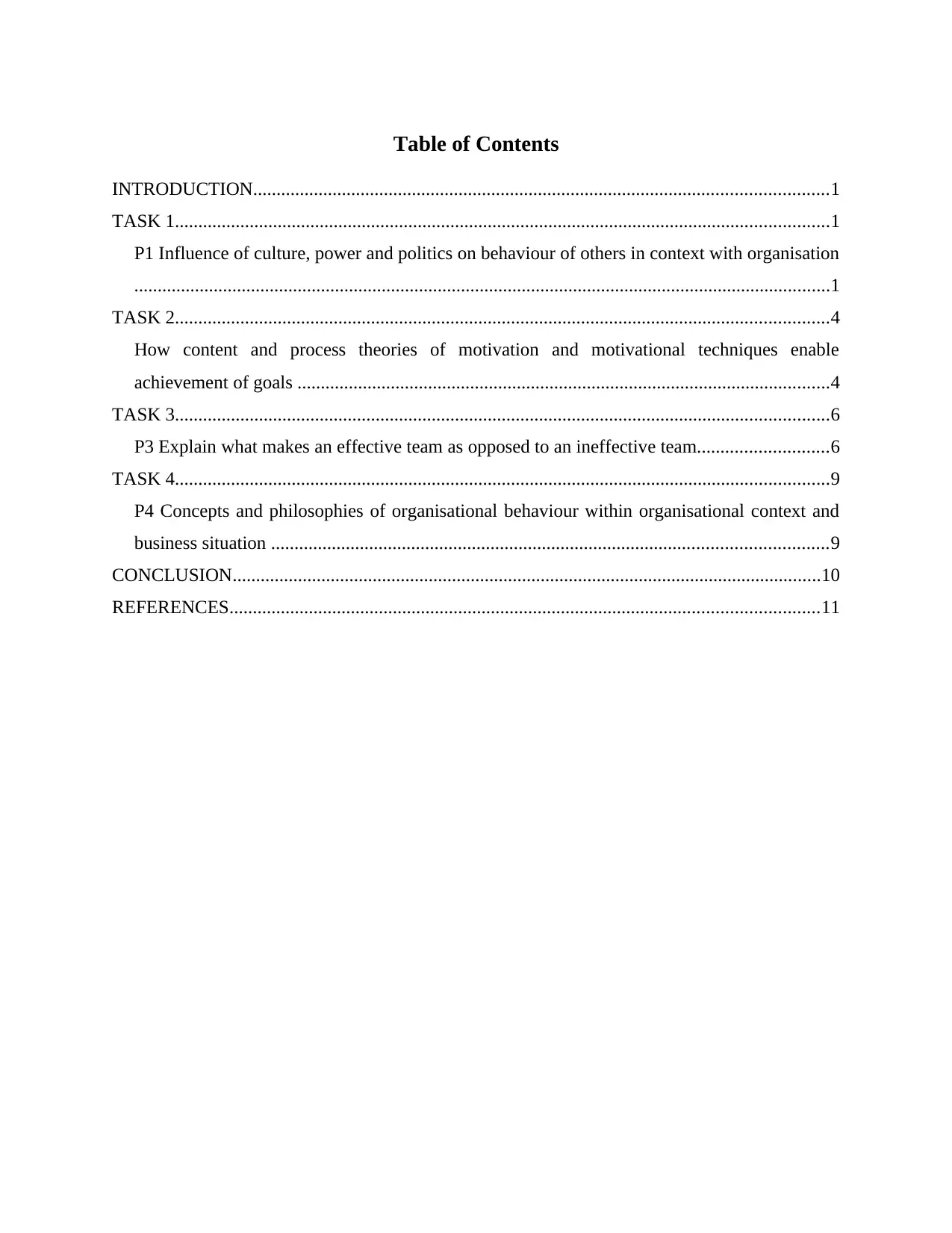
Table of Contents
INTRODUCTION...........................................................................................................................1
TASK 1............................................................................................................................................1
P1 Influence of culture, power and politics on behaviour of others in context with organisation
.....................................................................................................................................................1
TASK 2............................................................................................................................................4
How content and process theories of motivation and motivational techniques enable
achievement of goals ..................................................................................................................4
TASK 3............................................................................................................................................6
P3 Explain what makes an effective team as opposed to an ineffective team............................6
TASK 4............................................................................................................................................9
P4 Concepts and philosophies of organisational behaviour within organisational context and
business situation .......................................................................................................................9
CONCLUSION..............................................................................................................................10
REFERENCES..............................................................................................................................11
INTRODUCTION...........................................................................................................................1
TASK 1............................................................................................................................................1
P1 Influence of culture, power and politics on behaviour of others in context with organisation
.....................................................................................................................................................1
TASK 2............................................................................................................................................4
How content and process theories of motivation and motivational techniques enable
achievement of goals ..................................................................................................................4
TASK 3............................................................................................................................................6
P3 Explain what makes an effective team as opposed to an ineffective team............................6
TASK 4............................................................................................................................................9
P4 Concepts and philosophies of organisational behaviour within organisational context and
business situation .......................................................................................................................9
CONCLUSION..............................................................................................................................10
REFERENCES..............................................................................................................................11

⊘ This is a preview!⊘
Do you want full access?
Subscribe today to unlock all pages.

Trusted by 1+ million students worldwide
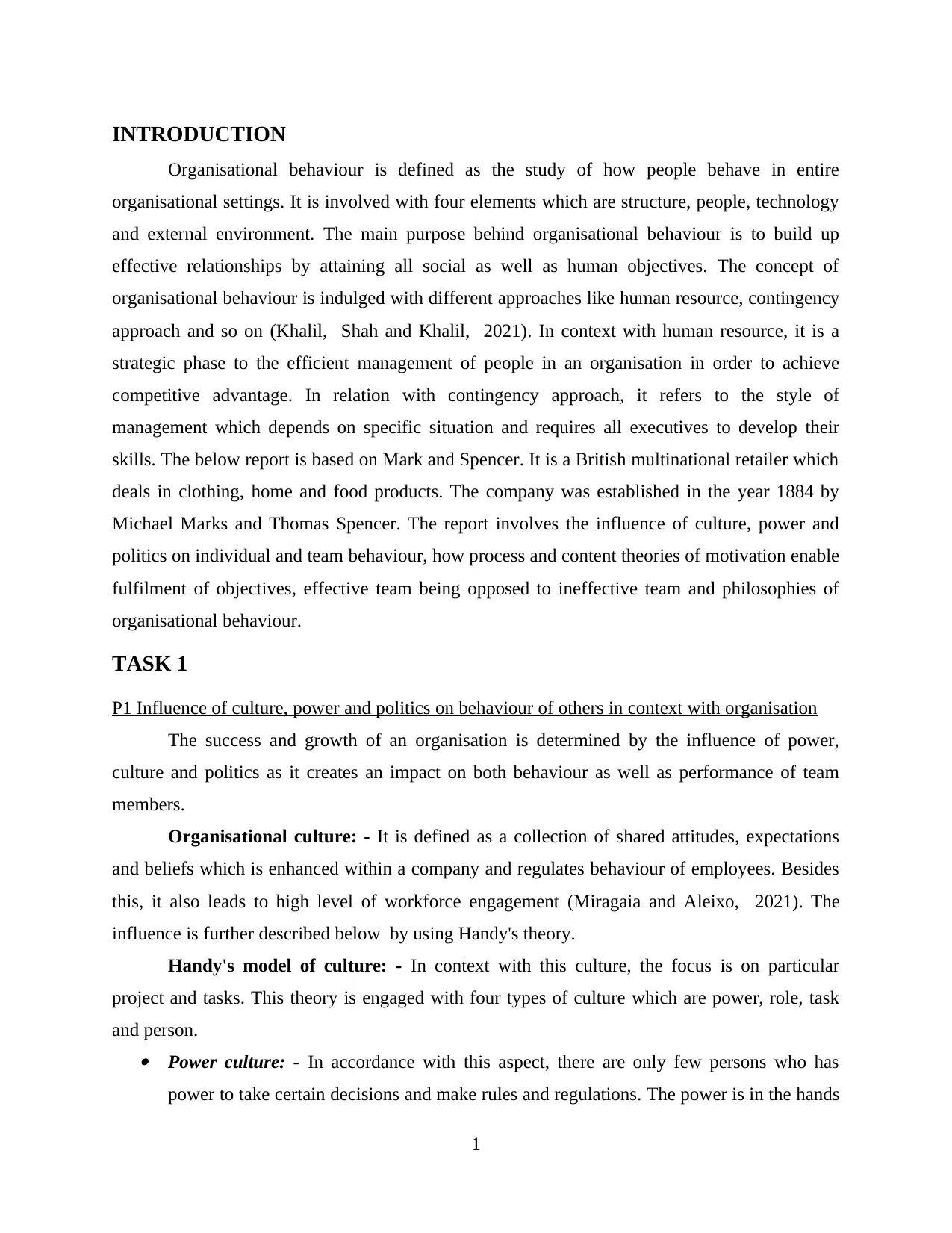
INTRODUCTION
Organisational behaviour is defined as the study of how people behave in entire
organisational settings. It is involved with four elements which are structure, people, technology
and external environment. The main purpose behind organisational behaviour is to build up
effective relationships by attaining all social as well as human objectives. The concept of
organisational behaviour is indulged with different approaches like human resource, contingency
approach and so on (Khalil, Shah and Khalil, 2021). In context with human resource, it is a
strategic phase to the efficient management of people in an organisation in order to achieve
competitive advantage. In relation with contingency approach, it refers to the style of
management which depends on specific situation and requires all executives to develop their
skills. The below report is based on Mark and Spencer. It is a British multinational retailer which
deals in clothing, home and food products. The company was established in the year 1884 by
Michael Marks and Thomas Spencer. The report involves the influence of culture, power and
politics on individual and team behaviour, how process and content theories of motivation enable
fulfilment of objectives, effective team being opposed to ineffective team and philosophies of
organisational behaviour.
TASK 1
P1 Influence of culture, power and politics on behaviour of others in context with organisation
The success and growth of an organisation is determined by the influence of power,
culture and politics as it creates an impact on both behaviour as well as performance of team
members.
Organisational culture: - It is defined as a collection of shared attitudes, expectations
and beliefs which is enhanced within a company and regulates behaviour of employees. Besides
this, it also leads to high level of workforce engagement (Miragaia and Aleixo, 2021). The
influence is further described below by using Handy's theory.
Handy's model of culture: - In context with this culture, the focus is on particular
project and tasks. This theory is engaged with four types of culture which are power, role, task
and person. Power culture: - In accordance with this aspect, there are only few persons who has
power to take certain decisions and make rules and regulations. The power is in the hands
1
Organisational behaviour is defined as the study of how people behave in entire
organisational settings. It is involved with four elements which are structure, people, technology
and external environment. The main purpose behind organisational behaviour is to build up
effective relationships by attaining all social as well as human objectives. The concept of
organisational behaviour is indulged with different approaches like human resource, contingency
approach and so on (Khalil, Shah and Khalil, 2021). In context with human resource, it is a
strategic phase to the efficient management of people in an organisation in order to achieve
competitive advantage. In relation with contingency approach, it refers to the style of
management which depends on specific situation and requires all executives to develop their
skills. The below report is based on Mark and Spencer. It is a British multinational retailer which
deals in clothing, home and food products. The company was established in the year 1884 by
Michael Marks and Thomas Spencer. The report involves the influence of culture, power and
politics on individual and team behaviour, how process and content theories of motivation enable
fulfilment of objectives, effective team being opposed to ineffective team and philosophies of
organisational behaviour.
TASK 1
P1 Influence of culture, power and politics on behaviour of others in context with organisation
The success and growth of an organisation is determined by the influence of power,
culture and politics as it creates an impact on both behaviour as well as performance of team
members.
Organisational culture: - It is defined as a collection of shared attitudes, expectations
and beliefs which is enhanced within a company and regulates behaviour of employees. Besides
this, it also leads to high level of workforce engagement (Miragaia and Aleixo, 2021). The
influence is further described below by using Handy's theory.
Handy's model of culture: - In context with this culture, the focus is on particular
project and tasks. This theory is engaged with four types of culture which are power, role, task
and person. Power culture: - In accordance with this aspect, there are only few persons who has
power to take certain decisions and make rules and regulations. The power is in the hands
1
Paraphrase This Document
Need a fresh take? Get an instant paraphrase of this document with our AI Paraphraser
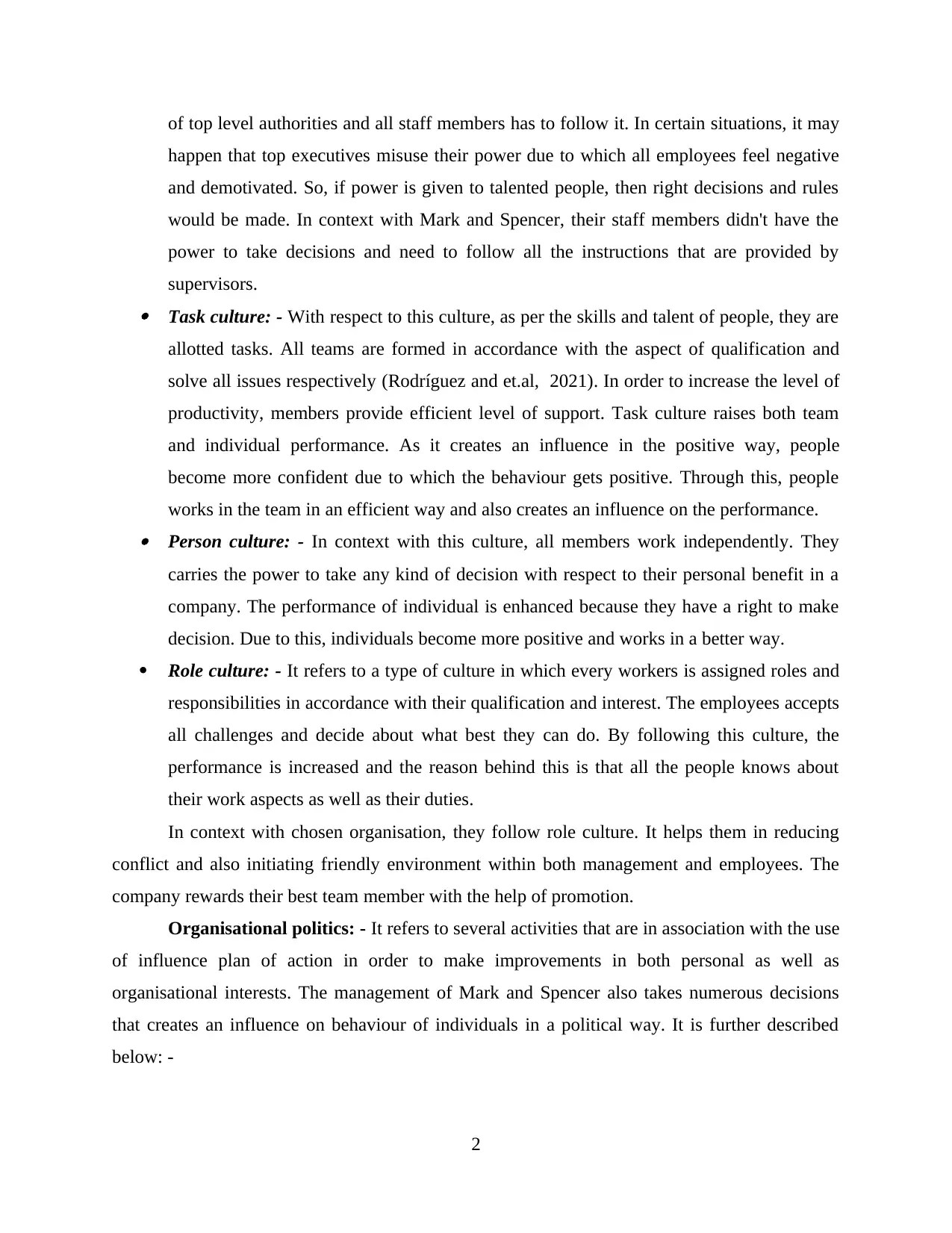
of top level authorities and all staff members has to follow it. In certain situations, it may
happen that top executives misuse their power due to which all employees feel negative
and demotivated. So, if power is given to talented people, then right decisions and rules
would be made. In context with Mark and Spencer, their staff members didn't have the
power to take decisions and need to follow all the instructions that are provided by
supervisors. Task culture: - With respect to this culture, as per the skills and talent of people, they are
allotted tasks. All teams are formed in accordance with the aspect of qualification and
solve all issues respectively (Rodríguez and et.al, 2021). In order to increase the level of
productivity, members provide efficient level of support. Task culture raises both team
and individual performance. As it creates an influence in the positive way, people
become more confident due to which the behaviour gets positive. Through this, people
works in the team in an efficient way and also creates an influence on the performance. Person culture: - In context with this culture, all members work independently. They
carries the power to take any kind of decision with respect to their personal benefit in a
company. The performance of individual is enhanced because they have a right to make
decision. Due to this, individuals become more positive and works in a better way.
Role culture: - It refers to a type of culture in which every workers is assigned roles and
responsibilities in accordance with their qualification and interest. The employees accepts
all challenges and decide about what best they can do. By following this culture, the
performance is increased and the reason behind this is that all the people knows about
their work aspects as well as their duties.
In context with chosen organisation, they follow role culture. It helps them in reducing
conflict and also initiating friendly environment within both management and employees. The
company rewards their best team member with the help of promotion.
Organisational politics: - It refers to several activities that are in association with the use
of influence plan of action in order to make improvements in both personal as well as
organisational interests. The management of Mark and Spencer also takes numerous decisions
that creates an influence on behaviour of individuals in a political way. It is further described
below: -
2
happen that top executives misuse their power due to which all employees feel negative
and demotivated. So, if power is given to talented people, then right decisions and rules
would be made. In context with Mark and Spencer, their staff members didn't have the
power to take decisions and need to follow all the instructions that are provided by
supervisors. Task culture: - With respect to this culture, as per the skills and talent of people, they are
allotted tasks. All teams are formed in accordance with the aspect of qualification and
solve all issues respectively (Rodríguez and et.al, 2021). In order to increase the level of
productivity, members provide efficient level of support. Task culture raises both team
and individual performance. As it creates an influence in the positive way, people
become more confident due to which the behaviour gets positive. Through this, people
works in the team in an efficient way and also creates an influence on the performance. Person culture: - In context with this culture, all members work independently. They
carries the power to take any kind of decision with respect to their personal benefit in a
company. The performance of individual is enhanced because they have a right to make
decision. Due to this, individuals become more positive and works in a better way.
Role culture: - It refers to a type of culture in which every workers is assigned roles and
responsibilities in accordance with their qualification and interest. The employees accepts
all challenges and decide about what best they can do. By following this culture, the
performance is increased and the reason behind this is that all the people knows about
their work aspects as well as their duties.
In context with chosen organisation, they follow role culture. It helps them in reducing
conflict and also initiating friendly environment within both management and employees. The
company rewards their best team member with the help of promotion.
Organisational politics: - It refers to several activities that are in association with the use
of influence plan of action in order to make improvements in both personal as well as
organisational interests. The management of Mark and Spencer also takes numerous decisions
that creates an influence on behaviour of individuals in a political way. It is further described
below: -
2
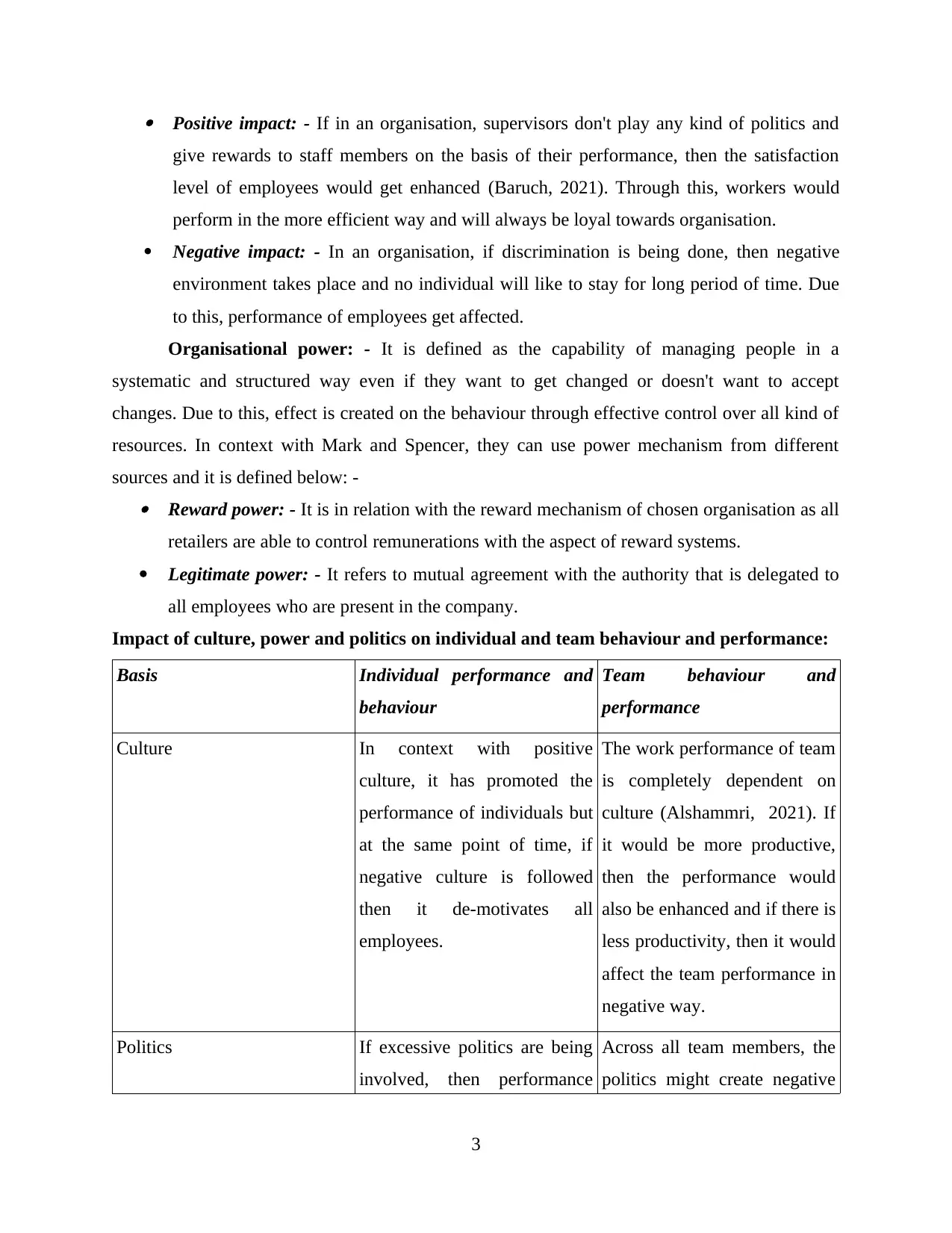
Positive impact: - If in an organisation, supervisors don't play any kind of politics and
give rewards to staff members on the basis of their performance, then the satisfaction
level of employees would get enhanced (Baruch, 2021). Through this, workers would
perform in the more efficient way and will always be loyal towards organisation.
Negative impact: - In an organisation, if discrimination is being done, then negative
environment takes place and no individual will like to stay for long period of time. Due
to this, performance of employees get affected.
Organisational power: - It is defined as the capability of managing people in a
systematic and structured way even if they want to get changed or doesn't want to accept
changes. Due to this, effect is created on the behaviour through effective control over all kind of
resources. In context with Mark and Spencer, they can use power mechanism from different
sources and it is defined below: - Reward power: - It is in relation with the reward mechanism of chosen organisation as all
retailers are able to control remunerations with the aspect of reward systems.
Legitimate power: - It refers to mutual agreement with the authority that is delegated to
all employees who are present in the company.
Impact of culture, power and politics on individual and team behaviour and performance:
Basis Individual performance and
behaviour
Team behaviour and
performance
Culture In context with positive
culture, it has promoted the
performance of individuals but
at the same point of time, if
negative culture is followed
then it de-motivates all
employees.
The work performance of team
is completely dependent on
culture (Alshammri, 2021). If
it would be more productive,
then the performance would
also be enhanced and if there is
less productivity, then it would
affect the team performance in
negative way.
Politics If excessive politics are being
involved, then performance
Across all team members, the
politics might create negative
3
give rewards to staff members on the basis of their performance, then the satisfaction
level of employees would get enhanced (Baruch, 2021). Through this, workers would
perform in the more efficient way and will always be loyal towards organisation.
Negative impact: - In an organisation, if discrimination is being done, then negative
environment takes place and no individual will like to stay for long period of time. Due
to this, performance of employees get affected.
Organisational power: - It is defined as the capability of managing people in a
systematic and structured way even if they want to get changed or doesn't want to accept
changes. Due to this, effect is created on the behaviour through effective control over all kind of
resources. In context with Mark and Spencer, they can use power mechanism from different
sources and it is defined below: - Reward power: - It is in relation with the reward mechanism of chosen organisation as all
retailers are able to control remunerations with the aspect of reward systems.
Legitimate power: - It refers to mutual agreement with the authority that is delegated to
all employees who are present in the company.
Impact of culture, power and politics on individual and team behaviour and performance:
Basis Individual performance and
behaviour
Team behaviour and
performance
Culture In context with positive
culture, it has promoted the
performance of individuals but
at the same point of time, if
negative culture is followed
then it de-motivates all
employees.
The work performance of team
is completely dependent on
culture (Alshammri, 2021). If
it would be more productive,
then the performance would
also be enhanced and if there is
less productivity, then it would
affect the team performance in
negative way.
Politics If excessive politics are being
involved, then performance
Across all team members, the
politics might create negative
3
⊘ This is a preview!⊘
Do you want full access?
Subscribe today to unlock all pages.

Trusted by 1+ million students worldwide
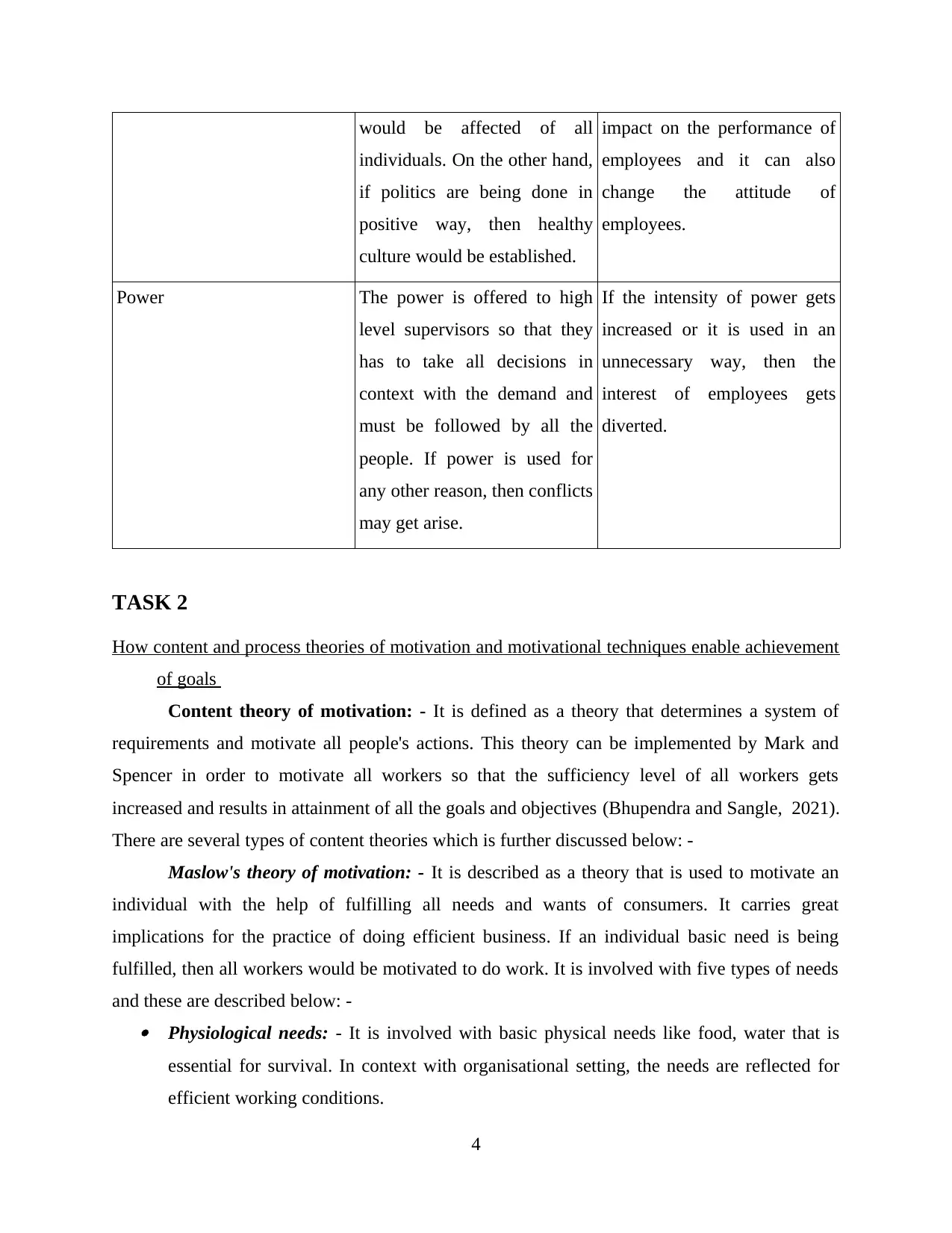
would be affected of all
individuals. On the other hand,
if politics are being done in
positive way, then healthy
culture would be established.
impact on the performance of
employees and it can also
change the attitude of
employees.
Power The power is offered to high
level supervisors so that they
has to take all decisions in
context with the demand and
must be followed by all the
people. If power is used for
any other reason, then conflicts
may get arise.
If the intensity of power gets
increased or it is used in an
unnecessary way, then the
interest of employees gets
diverted.
TASK 2
How content and process theories of motivation and motivational techniques enable achievement
of goals
Content theory of motivation: - It is defined as a theory that determines a system of
requirements and motivate all people's actions. This theory can be implemented by Mark and
Spencer in order to motivate all workers so that the sufficiency level of all workers gets
increased and results in attainment of all the goals and objectives (Bhupendra and Sangle, 2021).
There are several types of content theories which is further discussed below: -
Maslow's theory of motivation: - It is described as a theory that is used to motivate an
individual with the help of fulfilling all needs and wants of consumers. It carries great
implications for the practice of doing efficient business. If an individual basic need is being
fulfilled, then all workers would be motivated to do work. It is involved with five types of needs
and these are described below: - Physiological needs: - It is involved with basic physical needs like food, water that is
essential for survival. In context with organisational setting, the needs are reflected for
efficient working conditions.
4
individuals. On the other hand,
if politics are being done in
positive way, then healthy
culture would be established.
impact on the performance of
employees and it can also
change the attitude of
employees.
Power The power is offered to high
level supervisors so that they
has to take all decisions in
context with the demand and
must be followed by all the
people. If power is used for
any other reason, then conflicts
may get arise.
If the intensity of power gets
increased or it is used in an
unnecessary way, then the
interest of employees gets
diverted.
TASK 2
How content and process theories of motivation and motivational techniques enable achievement
of goals
Content theory of motivation: - It is defined as a theory that determines a system of
requirements and motivate all people's actions. This theory can be implemented by Mark and
Spencer in order to motivate all workers so that the sufficiency level of all workers gets
increased and results in attainment of all the goals and objectives (Bhupendra and Sangle, 2021).
There are several types of content theories which is further discussed below: -
Maslow's theory of motivation: - It is described as a theory that is used to motivate an
individual with the help of fulfilling all needs and wants of consumers. It carries great
implications for the practice of doing efficient business. If an individual basic need is being
fulfilled, then all workers would be motivated to do work. It is involved with five types of needs
and these are described below: - Physiological needs: - It is involved with basic physical needs like food, water that is
essential for survival. In context with organisational setting, the needs are reflected for
efficient working conditions.
4
Paraphrase This Document
Need a fresh take? Get an instant paraphrase of this document with our AI Paraphraser
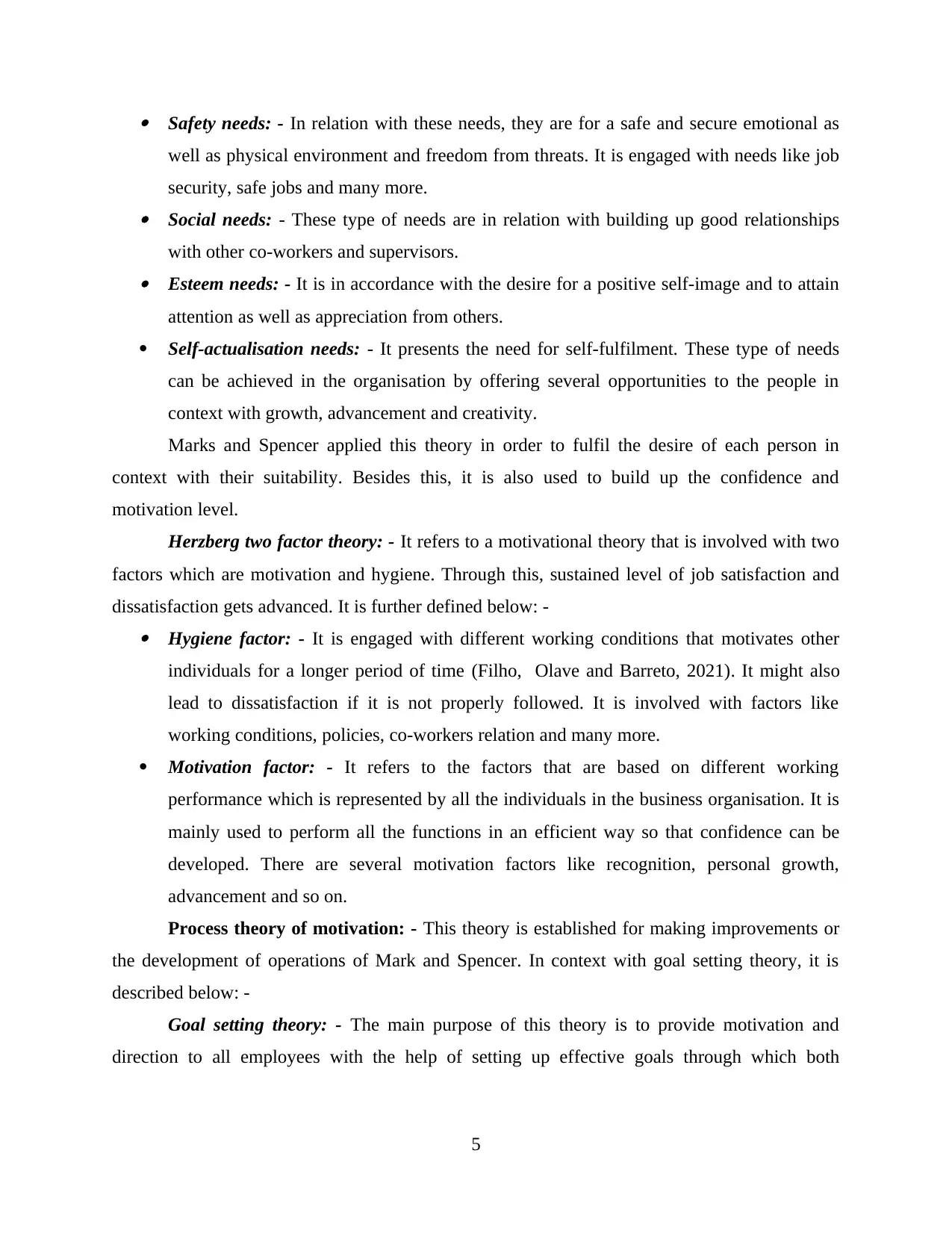
Safety needs: - In relation with these needs, they are for a safe and secure emotional as
well as physical environment and freedom from threats. It is engaged with needs like job
security, safe jobs and many more. Social needs: - These type of needs are in relation with building up good relationships
with other co-workers and supervisors. Esteem needs: - It is in accordance with the desire for a positive self-image and to attain
attention as well as appreciation from others.
Self-actualisation needs: - It presents the need for self-fulfilment. These type of needs
can be achieved in the organisation by offering several opportunities to the people in
context with growth, advancement and creativity.
Marks and Spencer applied this theory in order to fulfil the desire of each person in
context with their suitability. Besides this, it is also used to build up the confidence and
motivation level.
Herzberg two factor theory: - It refers to a motivational theory that is involved with two
factors which are motivation and hygiene. Through this, sustained level of job satisfaction and
dissatisfaction gets advanced. It is further defined below: - Hygiene factor: - It is engaged with different working conditions that motivates other
individuals for a longer period of time (Filho, Olave and Barreto, 2021). It might also
lead to dissatisfaction if it is not properly followed. It is involved with factors like
working conditions, policies, co-workers relation and many more.
Motivation factor: - It refers to the factors that are based on different working
performance which is represented by all the individuals in the business organisation. It is
mainly used to perform all the functions in an efficient way so that confidence can be
developed. There are several motivation factors like recognition, personal growth,
advancement and so on.
Process theory of motivation: - This theory is established for making improvements or
the development of operations of Mark and Spencer. In context with goal setting theory, it is
described below: -
Goal setting theory: - The main purpose of this theory is to provide motivation and
direction to all employees with the help of setting up effective goals through which both
5
well as physical environment and freedom from threats. It is engaged with needs like job
security, safe jobs and many more. Social needs: - These type of needs are in relation with building up good relationships
with other co-workers and supervisors. Esteem needs: - It is in accordance with the desire for a positive self-image and to attain
attention as well as appreciation from others.
Self-actualisation needs: - It presents the need for self-fulfilment. These type of needs
can be achieved in the organisation by offering several opportunities to the people in
context with growth, advancement and creativity.
Marks and Spencer applied this theory in order to fulfil the desire of each person in
context with their suitability. Besides this, it is also used to build up the confidence and
motivation level.
Herzberg two factor theory: - It refers to a motivational theory that is involved with two
factors which are motivation and hygiene. Through this, sustained level of job satisfaction and
dissatisfaction gets advanced. It is further defined below: - Hygiene factor: - It is engaged with different working conditions that motivates other
individuals for a longer period of time (Filho, Olave and Barreto, 2021). It might also
lead to dissatisfaction if it is not properly followed. It is involved with factors like
working conditions, policies, co-workers relation and many more.
Motivation factor: - It refers to the factors that are based on different working
performance which is represented by all the individuals in the business organisation. It is
mainly used to perform all the functions in an efficient way so that confidence can be
developed. There are several motivation factors like recognition, personal growth,
advancement and so on.
Process theory of motivation: - This theory is established for making improvements or
the development of operations of Mark and Spencer. In context with goal setting theory, it is
described below: -
Goal setting theory: - The main purpose of this theory is to provide motivation and
direction to all employees with the help of setting up effective goals through which both
5
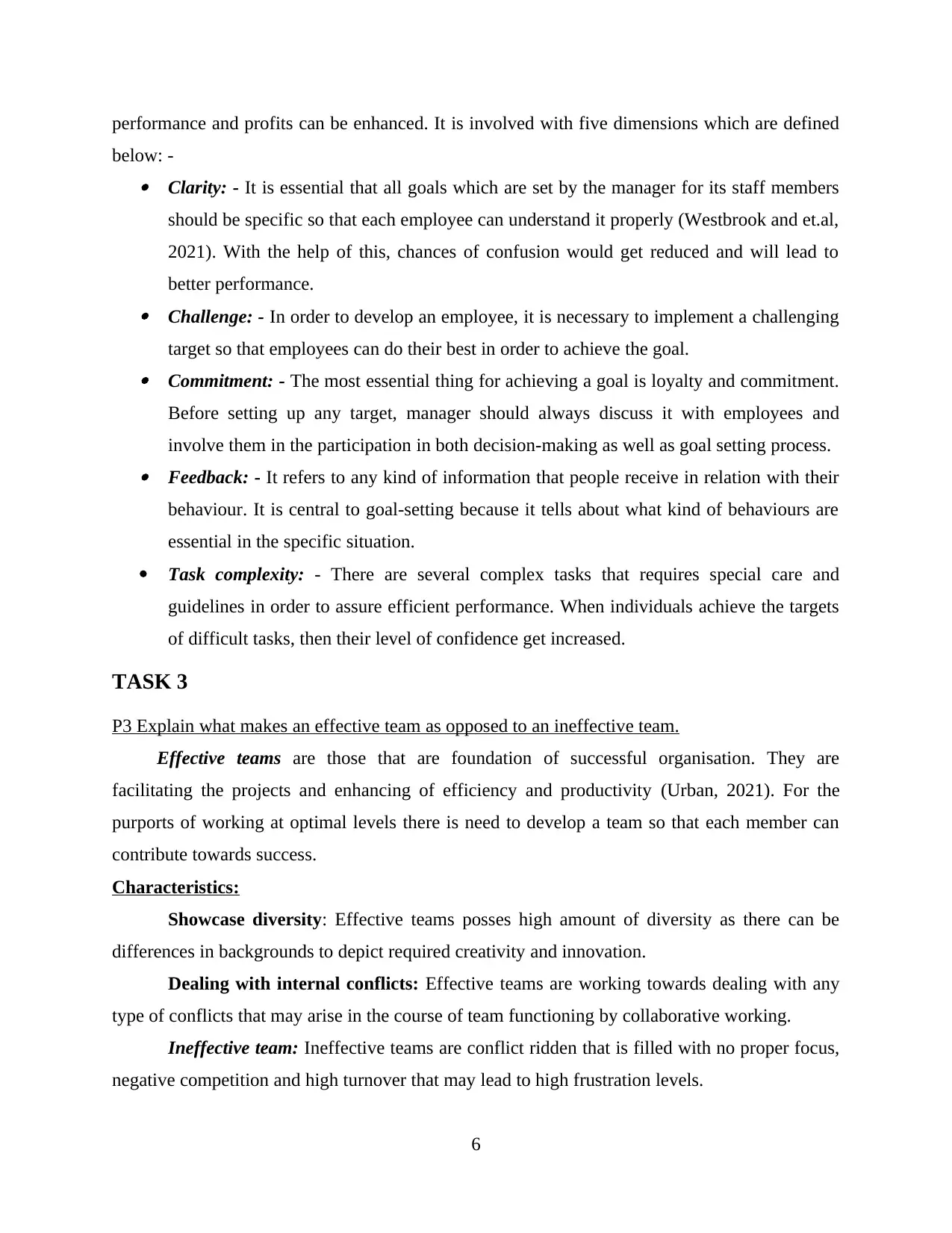
performance and profits can be enhanced. It is involved with five dimensions which are defined
below: - Clarity: - It is essential that all goals which are set by the manager for its staff members
should be specific so that each employee can understand it properly (Westbrook and et.al,
2021). With the help of this, chances of confusion would get reduced and will lead to
better performance. Challenge: - In order to develop an employee, it is necessary to implement a challenging
target so that employees can do their best in order to achieve the goal. Commitment: - The most essential thing for achieving a goal is loyalty and commitment.
Before setting up any target, manager should always discuss it with employees and
involve them in the participation in both decision-making as well as goal setting process. Feedback: - It refers to any kind of information that people receive in relation with their
behaviour. It is central to goal-setting because it tells about what kind of behaviours are
essential in the specific situation.
Task complexity: - There are several complex tasks that requires special care and
guidelines in order to assure efficient performance. When individuals achieve the targets
of difficult tasks, then their level of confidence get increased.
TASK 3
P3 Explain what makes an effective team as opposed to an ineffective team.
Effective teams are those that are foundation of successful organisation. They are
facilitating the projects and enhancing of efficiency and productivity (Urban, 2021). For the
purports of working at optimal levels there is need to develop a team so that each member can
contribute towards success.
Characteristics:
Showcase diversity: Effective teams posses high amount of diversity as there can be
differences in backgrounds to depict required creativity and innovation.
Dealing with internal conflicts: Effective teams are working towards dealing with any
type of conflicts that may arise in the course of team functioning by collaborative working.
Ineffective team: Ineffective teams are conflict ridden that is filled with no proper focus,
negative competition and high turnover that may lead to high frustration levels.
6
below: - Clarity: - It is essential that all goals which are set by the manager for its staff members
should be specific so that each employee can understand it properly (Westbrook and et.al,
2021). With the help of this, chances of confusion would get reduced and will lead to
better performance. Challenge: - In order to develop an employee, it is necessary to implement a challenging
target so that employees can do their best in order to achieve the goal. Commitment: - The most essential thing for achieving a goal is loyalty and commitment.
Before setting up any target, manager should always discuss it with employees and
involve them in the participation in both decision-making as well as goal setting process. Feedback: - It refers to any kind of information that people receive in relation with their
behaviour. It is central to goal-setting because it tells about what kind of behaviours are
essential in the specific situation.
Task complexity: - There are several complex tasks that requires special care and
guidelines in order to assure efficient performance. When individuals achieve the targets
of difficult tasks, then their level of confidence get increased.
TASK 3
P3 Explain what makes an effective team as opposed to an ineffective team.
Effective teams are those that are foundation of successful organisation. They are
facilitating the projects and enhancing of efficiency and productivity (Urban, 2021). For the
purports of working at optimal levels there is need to develop a team so that each member can
contribute towards success.
Characteristics:
Showcase diversity: Effective teams posses high amount of diversity as there can be
differences in backgrounds to depict required creativity and innovation.
Dealing with internal conflicts: Effective teams are working towards dealing with any
type of conflicts that may arise in the course of team functioning by collaborative working.
Ineffective team: Ineffective teams are conflict ridden that is filled with no proper focus,
negative competition and high turnover that may lead to high frustration levels.
6
⊘ This is a preview!⊘
Do you want full access?
Subscribe today to unlock all pages.

Trusted by 1+ million students worldwide
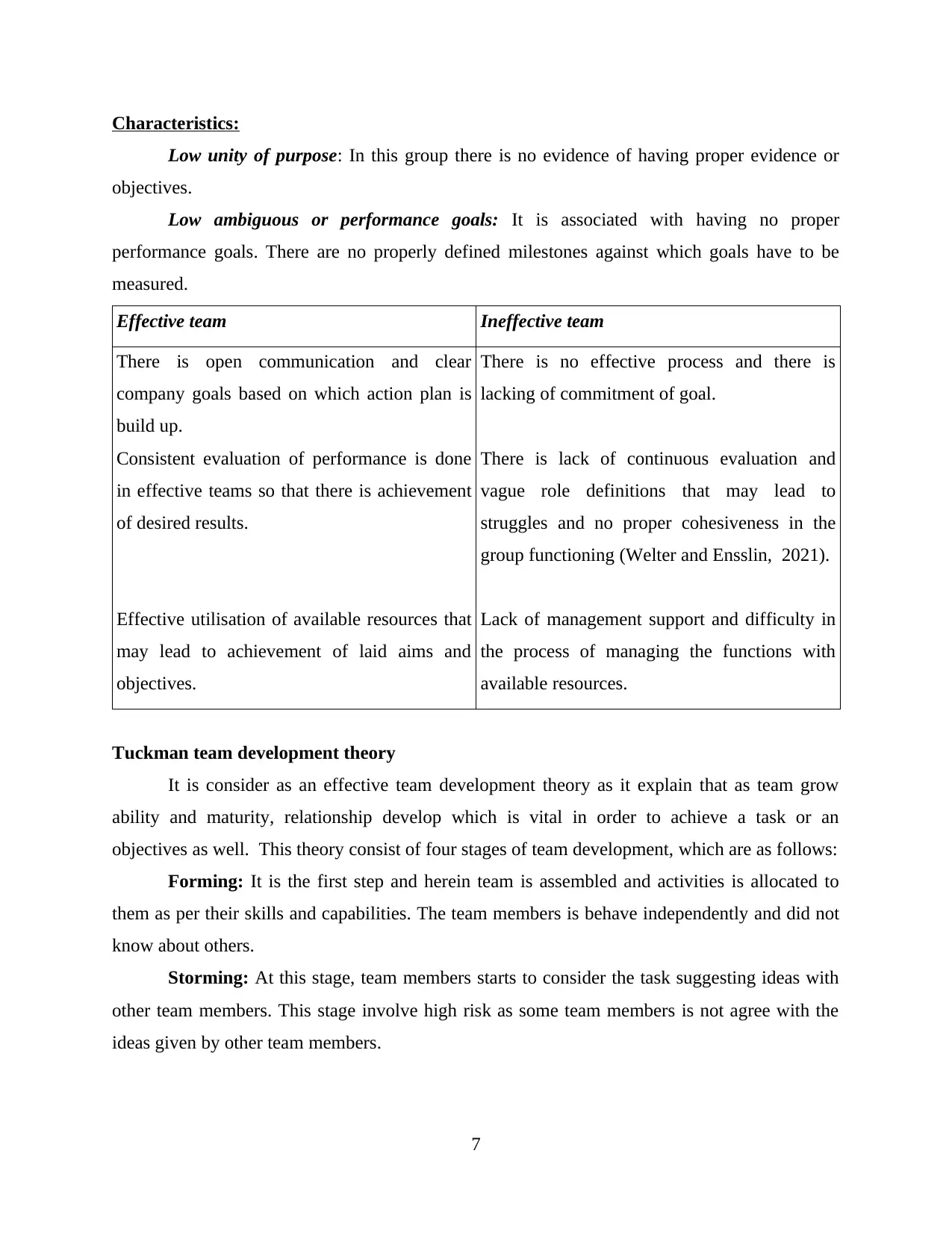
Characteristics:
Low unity of purpose: In this group there is no evidence of having proper evidence or
objectives.
Low ambiguous or performance goals: It is associated with having no proper
performance goals. There are no properly defined milestones against which goals have to be
measured.
Effective team Ineffective team
There is open communication and clear
company goals based on which action plan is
build up.
Consistent evaluation of performance is done
in effective teams so that there is achievement
of desired results.
Effective utilisation of available resources that
may lead to achievement of laid aims and
objectives.
There is no effective process and there is
lacking of commitment of goal.
There is lack of continuous evaluation and
vague role definitions that may lead to
struggles and no proper cohesiveness in the
group functioning (Welter and Ensslin, 2021).
Lack of management support and difficulty in
the process of managing the functions with
available resources.
Tuckman team development theory
It is consider as an effective team development theory as it explain that as team grow
ability and maturity, relationship develop which is vital in order to achieve a task or an
objectives as well. This theory consist of four stages of team development, which are as follows:
Forming: It is the first step and herein team is assembled and activities is allocated to
them as per their skills and capabilities. The team members is behave independently and did not
know about others.
Storming: At this stage, team members starts to consider the task suggesting ideas with
other team members. This stage involve high risk as some team members is not agree with the
ideas given by other team members.
7
Low unity of purpose: In this group there is no evidence of having proper evidence or
objectives.
Low ambiguous or performance goals: It is associated with having no proper
performance goals. There are no properly defined milestones against which goals have to be
measured.
Effective team Ineffective team
There is open communication and clear
company goals based on which action plan is
build up.
Consistent evaluation of performance is done
in effective teams so that there is achievement
of desired results.
Effective utilisation of available resources that
may lead to achievement of laid aims and
objectives.
There is no effective process and there is
lacking of commitment of goal.
There is lack of continuous evaluation and
vague role definitions that may lead to
struggles and no proper cohesiveness in the
group functioning (Welter and Ensslin, 2021).
Lack of management support and difficulty in
the process of managing the functions with
available resources.
Tuckman team development theory
It is consider as an effective team development theory as it explain that as team grow
ability and maturity, relationship develop which is vital in order to achieve a task or an
objectives as well. This theory consist of four stages of team development, which are as follows:
Forming: It is the first step and herein team is assembled and activities is allocated to
them as per their skills and capabilities. The team members is behave independently and did not
know about others.
Storming: At this stage, team members starts to consider the task suggesting ideas with
other team members. This stage involve high risk as some team members is not agree with the
ideas given by other team members.
7
Paraphrase This Document
Need a fresh take? Get an instant paraphrase of this document with our AI Paraphraser
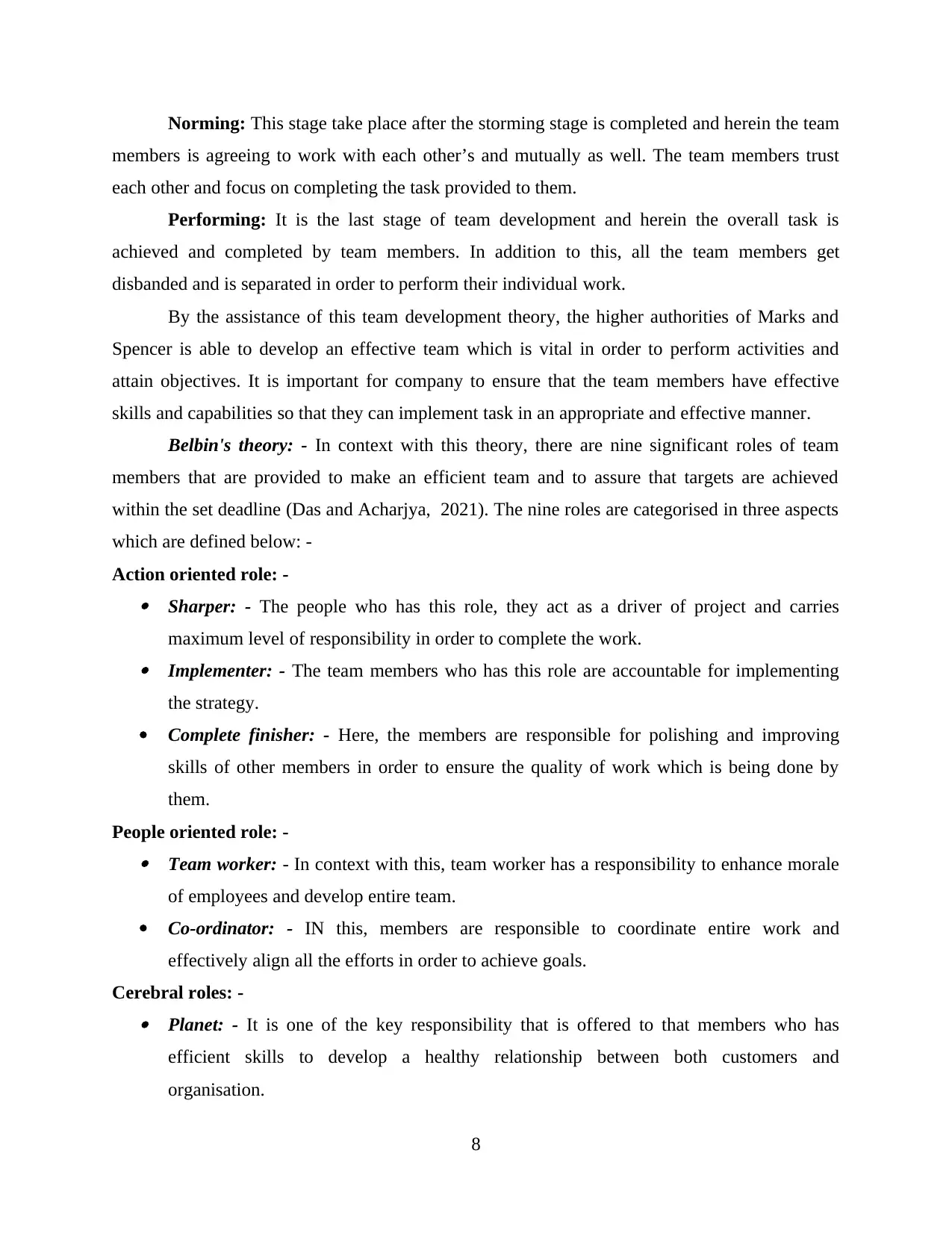
Norming: This stage take place after the storming stage is completed and herein the team
members is agreeing to work with each other’s and mutually as well. The team members trust
each other and focus on completing the task provided to them.
Performing: It is the last stage of team development and herein the overall task is
achieved and completed by team members. In addition to this, all the team members get
disbanded and is separated in order to perform their individual work.
By the assistance of this team development theory, the higher authorities of Marks and
Spencer is able to develop an effective team which is vital in order to perform activities and
attain objectives. It is important for company to ensure that the team members have effective
skills and capabilities so that they can implement task in an appropriate and effective manner.
Belbin's theory: - In context with this theory, there are nine significant roles of team
members that are provided to make an efficient team and to assure that targets are achieved
within the set deadline (Das and Acharjya, 2021). The nine roles are categorised in three aspects
which are defined below: -
Action oriented role: - Sharper: - The people who has this role, they act as a driver of project and carries
maximum level of responsibility in order to complete the work. Implementer: - The team members who has this role are accountable for implementing
the strategy.
Complete finisher: - Here, the members are responsible for polishing and improving
skills of other members in order to ensure the quality of work which is being done by
them.
People oriented role: - Team worker: - In context with this, team worker has a responsibility to enhance morale
of employees and develop entire team.
Co-ordinator: - IN this, members are responsible to coordinate entire work and
effectively align all the efforts in order to achieve goals.
Cerebral roles: - Planet: - It is one of the key responsibility that is offered to that members who has
efficient skills to develop a healthy relationship between both customers and
organisation.
8
members is agreeing to work with each other’s and mutually as well. The team members trust
each other and focus on completing the task provided to them.
Performing: It is the last stage of team development and herein the overall task is
achieved and completed by team members. In addition to this, all the team members get
disbanded and is separated in order to perform their individual work.
By the assistance of this team development theory, the higher authorities of Marks and
Spencer is able to develop an effective team which is vital in order to perform activities and
attain objectives. It is important for company to ensure that the team members have effective
skills and capabilities so that they can implement task in an appropriate and effective manner.
Belbin's theory: - In context with this theory, there are nine significant roles of team
members that are provided to make an efficient team and to assure that targets are achieved
within the set deadline (Das and Acharjya, 2021). The nine roles are categorised in three aspects
which are defined below: -
Action oriented role: - Sharper: - The people who has this role, they act as a driver of project and carries
maximum level of responsibility in order to complete the work. Implementer: - The team members who has this role are accountable for implementing
the strategy.
Complete finisher: - Here, the members are responsible for polishing and improving
skills of other members in order to ensure the quality of work which is being done by
them.
People oriented role: - Team worker: - In context with this, team worker has a responsibility to enhance morale
of employees and develop entire team.
Co-ordinator: - IN this, members are responsible to coordinate entire work and
effectively align all the efforts in order to achieve goals.
Cerebral roles: - Planet: - It is one of the key responsibility that is offered to that members who has
efficient skills to develop a healthy relationship between both customers and
organisation.
8
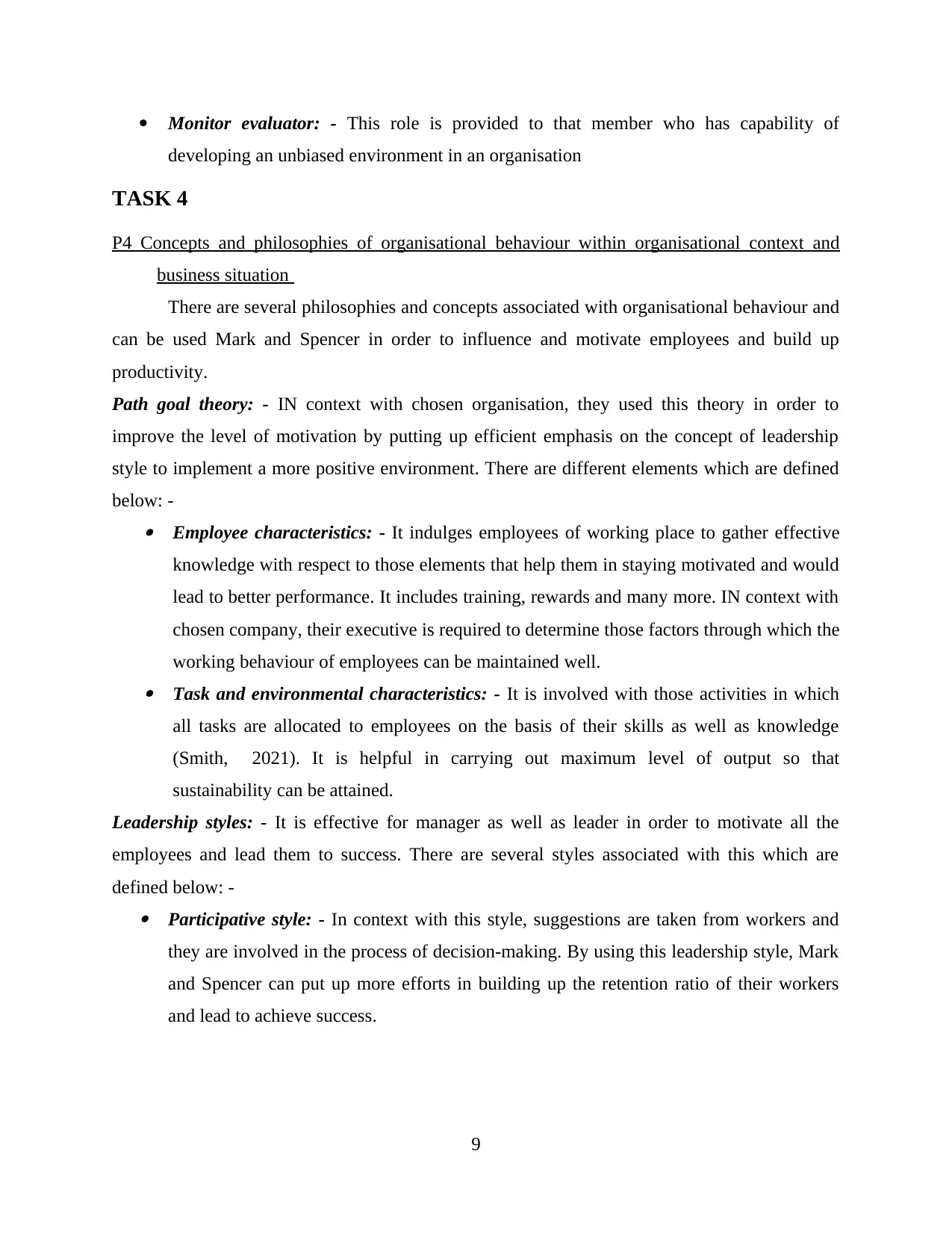
Monitor evaluator: - This role is provided to that member who has capability of
developing an unbiased environment in an organisation
TASK 4
P4 Concepts and philosophies of organisational behaviour within organisational context and
business situation
There are several philosophies and concepts associated with organisational behaviour and
can be used Mark and Spencer in order to influence and motivate employees and build up
productivity.
Path goal theory: - IN context with chosen organisation, they used this theory in order to
improve the level of motivation by putting up efficient emphasis on the concept of leadership
style to implement a more positive environment. There are different elements which are defined
below: - Employee characteristics: - It indulges employees of working place to gather effective
knowledge with respect to those elements that help them in staying motivated and would
lead to better performance. It includes training, rewards and many more. IN context with
chosen company, their executive is required to determine those factors through which the
working behaviour of employees can be maintained well. Task and environmental characteristics: - It is involved with those activities in which
all tasks are allocated to employees on the basis of their skills as well as knowledge
(Smith, 2021). It is helpful in carrying out maximum level of output so that
sustainability can be attained.
Leadership styles: - It is effective for manager as well as leader in order to motivate all the
employees and lead them to success. There are several styles associated with this which are
defined below: - Participative style: - In context with this style, suggestions are taken from workers and
they are involved in the process of decision-making. By using this leadership style, Mark
and Spencer can put up more efforts in building up the retention ratio of their workers
and lead to achieve success.
9
developing an unbiased environment in an organisation
TASK 4
P4 Concepts and philosophies of organisational behaviour within organisational context and
business situation
There are several philosophies and concepts associated with organisational behaviour and
can be used Mark and Spencer in order to influence and motivate employees and build up
productivity.
Path goal theory: - IN context with chosen organisation, they used this theory in order to
improve the level of motivation by putting up efficient emphasis on the concept of leadership
style to implement a more positive environment. There are different elements which are defined
below: - Employee characteristics: - It indulges employees of working place to gather effective
knowledge with respect to those elements that help them in staying motivated and would
lead to better performance. It includes training, rewards and many more. IN context with
chosen company, their executive is required to determine those factors through which the
working behaviour of employees can be maintained well. Task and environmental characteristics: - It is involved with those activities in which
all tasks are allocated to employees on the basis of their skills as well as knowledge
(Smith, 2021). It is helpful in carrying out maximum level of output so that
sustainability can be attained.
Leadership styles: - It is effective for manager as well as leader in order to motivate all the
employees and lead them to success. There are several styles associated with this which are
defined below: - Participative style: - In context with this style, suggestions are taken from workers and
they are involved in the process of decision-making. By using this leadership style, Mark
and Spencer can put up more efforts in building up the retention ratio of their workers
and lead to achieve success.
9
⊘ This is a preview!⊘
Do you want full access?
Subscribe today to unlock all pages.

Trusted by 1+ million students worldwide
1 out of 14
Related Documents
Your All-in-One AI-Powered Toolkit for Academic Success.
+13062052269
info@desklib.com
Available 24*7 on WhatsApp / Email
![[object Object]](/_next/static/media/star-bottom.7253800d.svg)
Unlock your academic potential
Copyright © 2020–2025 A2Z Services. All Rights Reserved. Developed and managed by ZUCOL.



